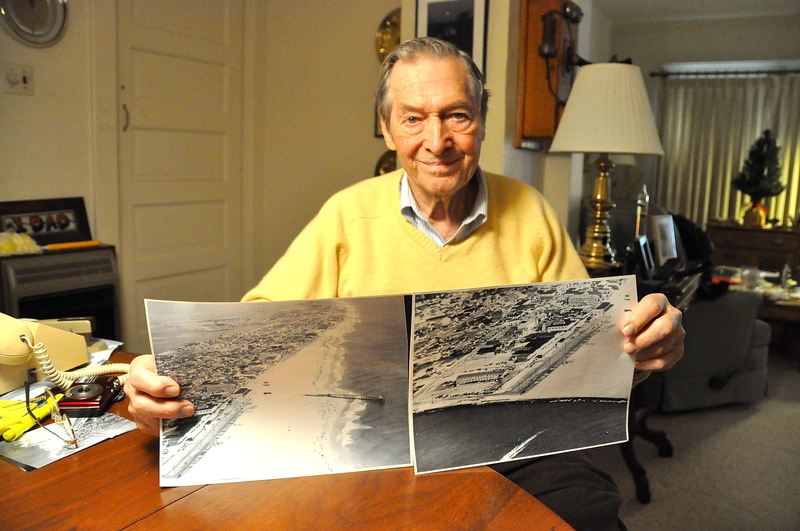As a pilot, M.A. Keller has flown over the Indian River Inlet area many times, watching how the elements and time have changed the shoreline, especially the beach north of Indian River Inlet.
Keller says although he's not an engineer, he knows what's causing erosion of the beach north of the inlet: the north jetty is failing.
“The rock pile is broken down on the north jetty,” he said.
The breakdown of the jetty allows sand to flow from the northside beach into the inlet and then back to the south shore of the inlet, Keller said. He looks at a photograph showing the south jetty extending beyond the north-side jetty. “The north jetty needs to be rebuilt to be parallel with the south side,” he said.
Department of Natural Resources and Environmental Control officials are also aware of problems with the jetty, and the U.S. Army Corps has plans to fix a section of the jetty. Keller says the corps' plans are inadequate.
Keller, 89, says Delaware officials should take a page from Maryland's beach preservation book, which he says has helped build up the beach in Ocean City.
When he was a young man, Keller says, the beach was narrow and waves sometimes broke onto the boardwalk. It wasn't until work was done on Ocean City's north jetty that the beach started to rebuild to the wide beach it is today.
Keller said he watched the work being conducted by the U.S. Army Corps of Engineers in the mid-1940s as they sealed the jetty by pouring cement into bored holes. He said that stabilized the jetty and did not allow sand to pour out through holes and breaks.
The U.S. Army Corps has announced plans to pump sand from the bottom of the inlet to replenish the beach on the north side of the Indian River Inlet jetty. State crews will then rebuild the sand-depleted shoreline north of the bridge. Waves and storm surge from two storms over the past year have flooded Route 1 forcing closure of the road, closing the bridge.
Keller, an inventor and retired electrical contractor who has lived in an old farmhouse near Milton for 50 years, said he has tried to contact state officials to discuss his idea, but he has had no luck. “If they do what was done in Ocean City, the beach will build like it has there,” he said. “I have proof that it works. This may be technology that no one is aware of since it was done so long ago. Maybe no one knows this is a possibility.”
Keller is no stranger to being on the cutting edge of technology. He installed the first residential electric heat unit in Delaware in a Georgetown home.
Keller said he hates to see wasted time, money and effort, and that's what he sees happening at the Indian River Inlet. He said the sand-pumping system that moves sand from the south side of the inlet to rebuild the beach on the north side is a continuous cycle that will never cease. “They won't be able to stop the erosion; it's reached a point of no return,” he said. “It can't go on like this.”
Must stop flow of sand
William Friend, a retired DNREC employee, agrees with Keller that there are problems with the north-side jetty. But he has a different idea for a possible solution: a new rock structure jutting north from the present jetty.
He said a lot of the sand from the north-side beach ends up back in the inlet as it flows around the end of the northern jetty – even the sand pumped there by the bypass system. “They are fighting a losing battle there. They have to cut the sand flow,” he said.
If nothing is done to slow the sand flow, he said, the proposed replenishment project is for naught.
Like Keller, Friend said he has tried to contact state, but has has received no response.
Friend, 65, grew up on Lewes Beach and was among those evacuated from the are during the Storm of 62. He retired after working for DNREC for 20 years.























































